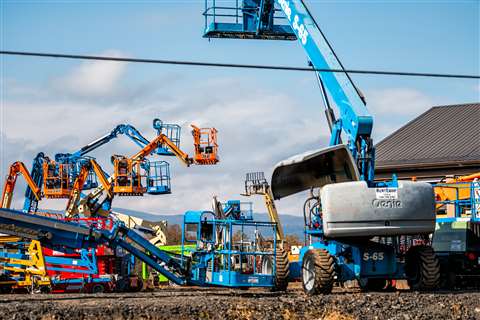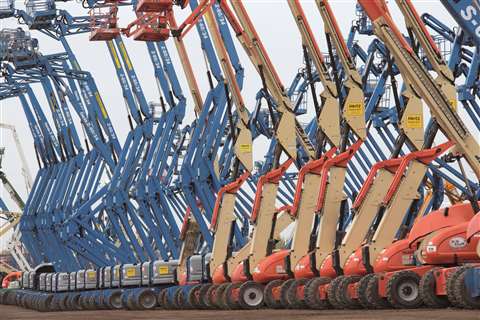What’s happening to used access equipment prices?
19 December 2022
The used equipment market soared in 2022 as buyers looking to purchase units faced delivery delays. Could 2023 see more of the same? ALH reports
In July 2022, used access equipment costs skyrocketed to record levels following 18 months of continuous pricing increases.
In its July monthly trends report, Ritchie Bros. noted the average purchase price at the time for used scissors rose 24 percent compared to the same period year-over-year, while booms saw an increase of 28 percent and telehandlers 26 percent. Sales volumes, however, had declined for all three categories.
 Buying used equipment can be a smart option in today’s market as purchasers continue to grapple with delayed deliveries. (Photo: Adobe Stock)
Buying used equipment can be a smart option in today’s market as purchasers continue to grapple with delayed deliveries. (Photo: Adobe Stock)
Fast forward to October 2022 and the latest aerial-focused Ritchie Bros. monthly trends report painted a different picture – median pricing for used scissor lifts, booms and telehandlers sold in the U.S. dropped during the third quarter when compared to both Q1 and Q2.
Meanwhile, sales volumes were a mixed bag, with boom lift sales overall flat, while scissors saw a slight increase and telehandlers trended down.
Looking to scissors sold in the U.S., Q3 marked a higher volume of sales (roughly 1,750 units compared to Q1’s previous high of around 1,200) with slightly lower pricing of roughly $3,900 compared to the prior quarter’s $4,000.
While Genie had been the number-one-selling brand in 2021, Skyjack took over the top spot for 2022 – both in the U.S. and Canadian markets.
For booms, median pricing of roughly $7,500 for Q3 was well below the previous two quarters’, with Q2 seeing prices above $13,000, but units sold surpassed both Q1 and Q2 at roughly 1,750 units.
Telehandlers continued to see consistently strong pricing in the U.S. used equipment market this year, with median pricing for all three quarters of 2022 resting right around $40,000, which exceed 2021 levels. Volumes slightly dipped in Q3 to 625 units – Q1 saw the highest at 650 – but Q3 sales outpaced the same period last year. JLG continued to be the top-selling brand with the state of Texas leading selling and buying activity.
Year total, Ritchie Bros. has sold more than 9,600 pieces of aerial equipment in the U.S. (and 1,400 across Canada.) For booms, the auction company reported strong demand and increased pricing when compared to Q2, with the highest buying and selling activity happening in Texas.
“Aerial equipment is everywhere, on nearly every jobsite, so it’s no surprise how much these assets trade through our online auctions and marketplaces,” said Doug Olive, SVP, pricing. “In Q3 2022, aerial equipment prices in the United States were up 3 percent at Ritchie Bros. year-over year, while prices in Canada were up 4 percent.”
Used rental equipment
Looking at some of the world’s largest equipment rental companies, used equipment sales were all over the board with some seeing significant decreases in volumes sold while others racked in millions of dollars in sales.
Boosting the value of used equipmentCompanies looking to add used equipment to expand their fleets or replace aging machines will also see bottom-line savings. United Rentals provides their top three tips for businesses to get the most out of their used machinery. Use Telematics to Boost Productivity Collecting and analyzing equipment data is critical to driving productivity. Telematics devices coupled with worksite management solutions can help companies monitor critical equipment information from fuel consumption and engine temperature to fluid levels and run time. Operators and managers can use data about equipment and vehicles to optimize usage and proactively manage maintenance. Tap an Equipment Maintenance Service Provider Maintaining a fleet and keeping up with inspection schedules are not easy and finding and keeping qualified technicians can increase the burden. Using an equipment maintenance service provider which offers a one-stop shop with standardized processes and rates will help take the maintenance and repair burden of used and other equipment off fleet owners. These services should include onsite maintenance and repair via dedicated technicians, as well as using telematics data to design an optimal preventative maintenance program so equipment owners maximize value from their fleet. Leverage Attachments to Turn Equipment into Multipurpose Machines Attachments, such as buckets, trenchers, compactors and more, add versatility and value to what a machine can contribute to a worksite. For example, with the right attachment, contractors can use mini excavators to remove tree stumps, compact soil, dig a pool and more. A good step in determining whether an attachment is the best course for a machine is to consult with an expert equipment rental provider. Adding the right attachment can help a company increase equipment utilization while not overwhelming the machine, and save money by reducing the need for additional equipment on the jobsite. |
For the world’s largest equipment rental company, used equipment sales were more or less the same when compared to the same period last year. United’s used sales in the third quarter decreased 1.1 percent year-over-year, generating $181 million of proceeds at a GAAP gross margin of 61.9 percent. For the same period last year, United saw $183 million of used equipment proceeds at a GAAP gross margin of 45.9 percent.
Speaking during an investors call in October, CEO Matthew Flannery said the company “intentionally held back on used equipment sales this year to make sure we had enough capacity for our customers. And even though we sold less fleet in the quarter on an OEC basis versus our original plan, our revenue from used sales in Q3 was essentially flat year-over-year, supported by very strong pricing.”
Flannery noted the move to hold onto fleet was to ensure United could support “stronger-than-expected” rental demand during its peak season, but also said the company hoped “to get to more normalized fleet rotation next year and the kind of used sales that you would have seen pre-Covid.”
On the upswing were Herc Rentals and Sunbelt Rentals, both of which reported quarterly used equipment sales up tens of millions. Herc reported used equipment sales for Q3 amounting to $54 million, up $10 million over 2022 while Sunbelt’s Q1 showed used sales increased 43 percent to $100.1 million compared year-over-year.
Aaron Birnbaum, Herc’s senior VP and COO, told investors, “It’s still a vibrant used equipment market. There’s still a lot of demand because there’s limited supply.
“If you look at the auction prices depending on the category, most of them probably peaked already and they’re starting to gradually roll over, but still higher than a normal baseline. So, it’s still a good – really good overall – used equipment market.”
On the other end of the spectrum, however, H&E Equipment Services saw used equipment sales for its third quarter decline $10.8 million, or 34.7 percent to $20.3 million.
Used equipment can save companies money
Auction and rental results aside, for a company considering new versus used equipment, buying “second hand” offers numerous advantages and benefits.
Used equipment not only saves money for a business to spend elsewhere, it also allows companies to focus on other matters at hand while growing their business. In a similar vein, buying used equipment also keeps credit at bay; by taking on less debt, buyers are protecting future “borrowing power” for additional investments.
Used equipment values also decrease slower than new – and the machinery holds its value. By some estimates, 20 to 40 percent of the value of new heavy equipment is lost to depreciation within the first year of ownership. By purchasing used units, buyers avoid the initial “it moved off the lot and in its place stayed a pile of cash” and reap the savings from a much lower rate of depreciation. This is due in large part because much of the asset depreciation has already occurred.
And, another one for the checkbook-balancers: Used equipment purchases cost buyers less interest than new. Most companies rely on financing to purchase new equipment, and that comes with loans and interest. Used equipment, and its often attractive price points, mean less financing and loans – and less interest to pay in the long run.
Flexibility when buying used equipment
Another benefit of buying used is that available inventory is vast. With new booms, scissors and telehandlers coming out every few years – if not sooner – the used equipment marketplace offers an extensive, region-stretching option. In addition, there’s often multiple generations of models available, meaning buyers can often find exactly what they’re looking for.
 A sea of equipment stretching over the 220-acre Ritchie Bros. auction site in Orlando, FL. (Photo: Ritchie Bros.)
A sea of equipment stretching over the 220-acre Ritchie Bros. auction site in Orlando, FL. (Photo: Ritchie Bros.)
As everyone in the industry is well-aware, new equipment delivery lead times are stretching well into 2023 (and 2024.) Buying new requires extensive planning, and even if times were “easier” and equipment was flowing into yards like water down a river, companies still might not see that new kit for months. When used equipment is purchased, it’s immediately handed over to the buyer. Aside from shipping – if a company isn’t local – the phrase “lead time” pretty much doesn’t exist.
Buying used equipment can also afford flexibility. Without digging too deep into the “rent versus own” debate, if a company is planning a project that requires a piece of equipment they don’t own, renting might be an ideal option, but with today’s market, who’s to say they’ll get what they want when they need it? Buying used equipment gives businesses the flexibility to either keep the equipment at the end of the project – or sell it. And if the company opts to sell, there’s potential to recoup most of that original investment if the equipment has remained in good condition and maintained.
Used equipment can also save on training costs. While new equipment gives owners and operators access to some of the latest and greatest technologies, it also comes with the need to learn those new technologies. Training will likely be required for anyone using new equipment, but when buying used, operators and fleet managers could already know how to operate and service the machinery – saving companies time and money.
Lastly, buying used booms, scissors and telehandlers adds a notch to any company’s “green line.” Buying used improves sustainability by giving a “second life” to assets that already exist. Many businesses today have goals to improve the sustainability of their operations and shrink carbon footprints. By taking on equipment that’s already around, it reduces the need for newly manufactured machinery and the related consumption of natural resources.
On a final note, not all used equipment was created – or maintained – equally. Buyers must seek out reputable dealers, auction companies or third-party sellers that are known for selling quality used equipment. After all, no one wants to spend more on repairs or maintenance that could have been prevented than the original purchase price. Research and read up on the business you’ll be buying from to ensure the equipment has been maintained and inspected in accordance with manufacturer specifications and requirements.
STAY CONNECTED



Receive the information you need when you need it through our world-leading magazines, newsletters and daily briefings.
CONNECT WITH THE TEAM








